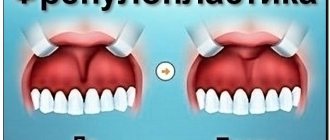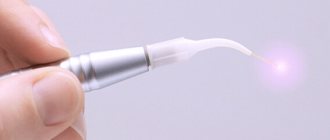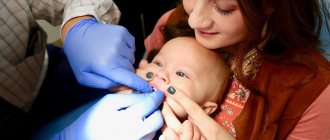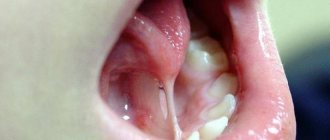Tongue frenulum cutting - what is it?
Plastic surgery of the lingual frenulum can be performed at different ages, but it is mainly performed on newborn children, since disruption of the formation of the mucosal fold under the tongue causes a number of functional disorders.
The procedure for trimming the frenulum of the tongue is a low-traumatic surgical procedure performed by a dentist. The frenulum of the tongue is a fold of the oral mucosa that stretches in the shape of an arc from the central point of the tongue to the middle of the lower dentition at the base of the gums. The main function of the frenulum is to attach the tongue to the lower part of the mouth.
If there are deviations in the location or length of the fold, the movement of the tongue will be impaired, resulting in incomplete functionality. The purpose of the operation is to increase the length or correct the position of the frenulum.
Short hyoid frenulum
- Speech therapist.No
- Consultations
- Short hyoid frenulum
During the consultation, you were told that the child has a short hyoid frenulum and in the future it will most likely need to be trimmed. What to do?
Hyoid frenulum
The sublingual frenulum is a membrane that is located under the tongue and connects the tongue to the sublingual space.
How to determine whether the hyoid frenulum is long enough?
Indeed, in different people the hyoid ligament (frenulum) can be of different lengths. If a child can stick his tongue out of his mouth and at the same time its tip does not bifurcate in the shape of two semicircular petals due to the fact that the hyoid ligament pulls it from below, if he can lick the saucer and click his tongue, then he will most likely have no obstacles for making sounds that require raising the tongue to the palate.
In a 5-year-old child, the frenulum in a stretched state should be at least 8 mm.
Short hyoid frenulum
A short hyoid ligament (frenulum) is a congenital defect consisting of shortening of the lingual frenulum (hyoid ligament).
What does this mean?
Short hyoid frenulum:
- may cause difficulty in tongue movements, because does not give him the opportunity to rise high. In this case, the so-called “upper sounds” suffer, i.e. the pronunciation of sounds such as Ш, Ж, Ш, ШЧ, Р, Рь is impaired
- can lead to a displacement of the center of the tongue, its asymmetrical development and low mobility, which prevents the formation of the correct articulatory posture of some sounds.
- may also be the cause of a violation of diction (Diction is clarity, intelligibility of pronunciation)
- in some cases, it can provoke problems with the formation of the lower jaw, i.e. The teeth may deviate and the necks of the teeth may become exposed. There is a risk of developing periodontitis and gingivitis. Therefore, a consultation with an orthodontist is necessary.
What to do?
There are two options to solve the problem:
- Stretching the hyoid frenulum
- Surgery
Stretching the hyoid frenulum
- This is reasonable if the frenulum is not very short, otherwise stretching a very short frenulum, according to some doctors, can lead to sagging of the mucous membrane, etc. the problems described above (periodontitis, gingivitis).
- Stretching is most successful up to 5 years of age. And the older the child, the more difficult it is.
- Stretching does not cause as much stress to the child as surgery, but it takes significantly more time and effort. After all, the corresponding exercises need to be performed several times a day, every day, and on a positive wave.
- Stretching with the help of speech therapy massage is an unpleasant process, often very painful for the child.
- Surgery is often easier for some parents.
Even if the frenulum is somewhat shortened (equal to 8 mm), it is better to stretch it than to operate
Many exercises can be started from a very early age. Remember! The baby will not be able to sit with you in front of the mirror and do the exercises according to your instructions. Turn everything into a game.
Exercises for the little ones
1) Lick the saucer. Invite your child to lick the saucer like a kitten.
2) Reach with your tongue for the spoon 3) Reach with your tongue to your chin 4) Reach with your tongue to your nose 5) Swing open your mouth, with the tip of your tongue reach first to the nose, and then to the chin, then again to the nose, and then again to the chin. 6) The horse smile, open his mouth. Click the tip of your tongue like a horse clicking. The mouth is open, the tongue should be wide. Make sure that the tip of the tongue does not turn inward, and that the lower jaw remains motionless. You can sit on a toy horse (if there is one in the house), or you can sit on your mother’s lap.
Exercises for older children
Along with the previous ones, you can do the following exercises:
1) Delicious jam: open your mouth slightly, the tongue moves along the upper lip from top to bottom, but not from side to side (as if licking the jam). The lower jaw should be motionless. 2) The painter invite the child to use his tongue, like a “brush,” to paint the ceiling in the “house” - the mouth. To do this, you need to open your mouth and stroke the palate with the wide tip of your tongue, making movements back and forth (from the teeth deep into the oral cavity and back). 3) Drum Show your child how to imitate a drum by beating a beat with your tongue. To do this, you need to open your mouth, smile slightly and, with the tense tip of your tongue, tap on the alveoli (tubercles behind the upper incisors), repeatedly and clearly, in one breath, pronouncing the sounds “D-D-D.” Tap slowly at first and then increase the tempo. Ask the child to repeat. Make sure that the child does not close his mouth during the exercise. 4) The fungus opens its mouth wide, presses the wide flat of the tongue against the palate and sucks it. Hold your tongue in this position for 5-10 seconds. The tongue will resemble the cap of a fungus, and the stretched hyoid ligament will resemble its thin leg. Then, “unstick” your tongue and close your mouth. Repeat the exercise 2-3 times. 5) Accordion Show your child how to draw an accordion using your tongue. To do this, you need to suck the wide tip of your tongue to the roof of your mouth, as in the “Mushroom” exercise, and then, without peeling off your tongue, open and close your mouth. The hyoid ligament (frenulum) will act as an accordion, which either stretches to its full length, then contracts.
Remember!
- Exercises must be performed systematically, gradually increasing the time they are performed (the number of repetitions of each exercise), only then will the desired effect be achieved.
- The sooner you start classes with your child, the faster you will achieve the desired result.
- The older the child, the more difficult it is to stretch the hyoid frenulum (targeted stretching of the hyoid frenulum using speech therapy massage is an unpleasant procedure, quite painful for the child). Stretching is most successful up to 5 years.
Surgery
Surgery is always stressful for a child
- You need a good doctor and modern equipment. Good reviews about the consequences of operations under local double anesthesia. But this is the doctor's choice.
- If something goes wrong, there is a risk of scar formation, making it difficult for the tongue to move.
- Short period of time for correcting sound pronunciation.
- After cutting, the hyoid ligament can grow back together if you don’t start working on it in time, i.e. no earlier than 10-14 days and no later than 1 month. after operation.
- Sometimes surgery is recommended for medical reasons by an orthodontist, not only because of shortcomings in sound pronunciation. If you do not trim the hyoid frenulum, then SOMETIMES there is a risk of periodontitis, gingivitis (bleeding, exposure of the necks of the teeth), large gaps between the teeth, deterioration of the natural self-cleaning of the oral cavity... But this is not immediately visible, everything is in the distant future... And it happens far from everyone, only a doctor can qualify such a case.
Indications for the procedure
For newborn children, cutting the frenulum of the tongue is recommended quite often. A pediatrician or dentist can identify the pathology. In most cases, disorders are detected already in the first months of a child’s life. At the same time, the doctor always takes into account the individual characteristics of the structure and position of the mucous fold.
If we are talking about a newborn baby, then plastic surgery is prescribed in the case of obvious pathology in the formation of the frenulum, or difficulties with breastfeeding. The baby may have difficulty latching on to the nipple or pacifier and difficulty sucking on the breast or bottle.
Untimely plastic surgery may subsequently lead to difficulties with chewing food, bite formation, and diction problems. In older age, recommendations for surgical treatment can be given by a speech therapist or orthodontist.
Where is frenuloplasty performed and which doctor should I contact?
If ankyloglossia is suspected, the child will be referred for consultation to a dentist, orthodontist or maxillofacial surgeon, who will confirm or refute the preliminary diagnosis. The decision about the need for surgical intervention will be made jointly by the orthopedist, surgeon and speech therapist.
There must be good reasons for this:
- serious nutritional problems in a newborn baby;
- speech therapy disorders that cannot be corrected by conventional means;
- malocclusion;
- violation of proper food intake;
- displacement of teeth, incisor inclination.
Experts divide the degree of pathology on a 5-point scale. Minor deviations can be successfully eliminated without surgery after the age of 1 year by performing special exercises.
The operation is performed in a maternity hospital or in dental clinics for older children. If the case is complex, they operate in the maxillofacial departments.
Contraindications
Tongue frenuloplasty in newborns does not involve major surgical intervention, so the operation is considered safe. In addition, the procedure is painless and does not require anesthesia. However, given that after cutting a short fold of mucosa, a small wound still forms, there are temporary restrictions on manipulation related to the child’s health condition.
Temporary contraindications:
- inflammatory diseases;
- infectious diseases;
- immunodeficiency pathologies;
- acute respiratory viral or bacterial infections.
If there are contraindications for health reasons, it is advisable to postpone the operation until complete recovery.
Preparing for surgery
Trimming the frenulum is a fairly simple operation that does not require special preparatory measures. Most often, the following procedures need to be performed before surgery:
- prepare a general blood test;
- check the blood for clotting (the so-called hemosyndrome test);
- do fluorography.
Carrying out an operation in infancy is easier for a child to tolerate due to the fact that he does not understand and does not remember what is happening around him.
At the age of one year, surgery is quite stressful for a baby, so it is very important to prepare him for this procedure in advance.
This requires psychological support from parents, encouragement and an explanation of the importance of the moment. To prevent your child from being capricious, you can take his favorite toys or a tablet with cartoons with him.
It is very important to ensure that the child is fed before the procedure, since after it you cannot eat for two hours.
Features of the procedure
Plastic surgery of the frenulum of the tongue involves cutting it with a scalpel or surgical scissors. After cutting the fold of the mucous membrane in a newborn, the tissue immediately stretches and lengthens after healing. When the operation is performed at the age of 3–5 years, the process of stretching the frenulum is more complex. To increase the length of the fold and prevent the formation of scars, the child will need to perform special exercises.
In Martinka dentistry, plastic surgery of the frenulum of the tongue and lip is performed not only by the classical, but also by the modern method using a laser. The use of laser equipment eliminates the risk of infection and bleeding. The laser has an antiseptic effect and instantly seals the vessels; moreover, during the operation there is no contact of the instrument with the tissues of the oral cavity. Laser surgery involves contraindications and is only allowed for children over 1 year of age.
For newborn children, tongue frenuloplasty can be performed without anesthesia. In children from 3 months of age, the folds of the mucous membrane thicken, which suggests discomfort and minor pain during the operation, so cutting the frenulum is done with local anesthesia. Sedation is used only in extreme cases, if the child has complex illnesses or increased anxiety.
How to do speech therapy massage for short tongue frenulum in children?
A special massage helps to lengthen the hyoid ligament very effectively. The child can do it independently or with the help of parents.
Massage to stretch the hyoid ligament:
- Using your thumb and index finger, you need to grab the tip of your tongue and lift it up. The mouth should be open during the massage. Using the fingers of the other hand, you need to move along the frenulum from bottom to top with stretching movements, as if pulling it out.
- The index and middle fingers should be placed under the tongue so that the frenulum is between them. Use your thumb to press on the front of the tongue and make outward lengthening movements. During such manipulation, the index and middle fingers should be motionless.
- The massage can be performed by simply stretching the tongue in different directions. Grasping the tip, carefully pull the tongue out.
Stages of the procedure
Trimming a short frenulum, despite the lack of complexity of the procedure, should be performed by a qualified specialist and in a medical facility. Patients do not require hospitalization. The operation takes no more than 10 minutes. Immediately after completion of the plastic surgery, the child is sent home. It is not recommended to feed the baby in the first two hours. Young children are allowed to drink water.
Stages of plastic surgery of the frenulum of the tongue.
- Preparation. The doctor asks parents for complaints, performs an examination and, if necessary, gives recommendations on preparation for the procedure.
- Operation. Administration of anesthesia, antiseptic treatment of the oral cavity, trimming of the frenulum.
In newborns, the integrity of the mucous membrane is restored in 1–3 days. The child may be restless on the first day. Difficulties with feeding cannot be ruled out, but already on the second day, babies begin to correctly take the breast or bottle nipple, which caused difficulties previously. Parents are advised to give the baby water after each feeding to avoid the accumulation of formula or milk in the mouth and the subsequent development of infection. Also, the mother must maintain breast hygiene and sterilize bottles.
Rehabilitation period
For babies under 9 months, the rehabilitation time is only a few hours, after which the baby can be put to the breast. In older children, the recovery period lasts about a day. After laser surgery, recovery is even faster.
Immediately after the operation, babies begin to eat normally without experiencing discomfort, and breast milk will help the wound in the mouth heal faster. Breasts quickly gain weight and grow well. Speech therapy disorders in children under one year of age are not diagnosed, and older children will require corrective work with a speech therapist. What exercises are recommended to be carried out in the presence of pathology can be seen in the video.
After frenuloplasty you should:
- do not eat for 2 hours;
- Do not eat irritating foods for 3-4 days - salty, spicy, sour and too hard;
- refuse hot food and drink;
- For some time it is better to eat food pureed;
- do not load your tongue with conversation;
- after eating, you must rinse your mouth with antiseptic agents (chamomile decoction, calendula tincture, Furacilin solution);
- do special exercises developed by your doctor;
- apply sea buckthorn oil and Solcoseryl to the surgical site;
- visit a speech therapist as prescribed by the attending physician;
- if there is pain, the child is given a painkiller (Nurofen, Ibuprofen).
results
The main goal of tongue frenuloplasty is to prevent tongue dysfunction that occurs subsequently. If you do not trim the folds of mucous membrane, then in the future the child may have difficulties with eating, diction and lip movements.
Don't be afraid of surgery. This is a simple procedure that takes a few minutes, and the cutting of the short frenulum itself takes place in a few seconds. Since the mucous membrane in children is still too thin, the child does not feel pain. Minor bleeding goes away quickly and does not pose any danger.
The help of a qualified dentist is an absolute guarantee of high-quality results and the absence of complications.
Features of sound production in children with a short frenulum
In the process of carrying out exercises and massage to stretch the hyoid frenulum, certain sounds are made:
- Sounds like [ch], [l], [sch], [d], [t] should be started when the frenulum has not yet fully stretched.
- The sounds [р], [ш], [ж] - these letters can be taught to children to pronounce after the frenulum is fully stretched. All other sounds are pronounced by the child without complications.
While performing all the exercises, remember that they need to be performed:
- regularly;
- with maximum efficiency;
- gradually increasing the time and amount of exercise.
As soon as you notice that your child’s pronunciation of sounds is incorrect or he cannot reach the palate with his tongue, you should immediately begin to perform the exercises described above. The sooner you start classes, the faster and easier it will be to achieve results. Stretching the frenulum is an unpleasant and even slightly painful procedure for the child. There is no need to expect great results after two or three days of training; you should be patient and gradually move towards your goal.











